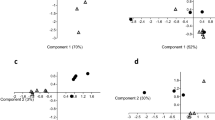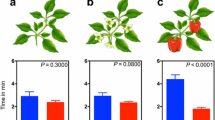Abstract
Induced plant responses to attack by chewing insects have been intensively studied, but little is known about plant responses to nonchewing insects or to attack by multiple herbivores with different feeding habits. We examined volatile emissions by tobacco, Nicotiana tabacum, in response to feeding by the piercing–sucking insect western flower thrips (WFT), Frankliniella occidentalis, the chewing herbivore Heliothis virescens, and both herbivores simultaneously. In addition, we examined the effects of herbivore-induced plant defenses on host-plant selection by WFT. Plants responded to thrips feeding by consistently releasing five compounds. Simultaneous feeding by WFT and H. virescens elicited the same 11 compounds emitted in response to caterpillar feeding alone; however, two compounds, α-humulene and caryophyllene oxide, were produced in greater amounts in response to simultaneous herbivory. In choice tests, thrips consistently preferred uninduced plants over all other treatments and preferred plants damaged by caterpillars and those treated with caterpillar saliva over those treated with caterpillar regurgitant. The results are consistent with a previous finding that caterpillar regurgitant induces the release of significantly more volatile nicotine than plants damaged by caterpillars or plants treated with caterpillar saliva. A repellent effect of nicotine on WFT was confirmed by encircling unwounded plants with septa releasing volatile nicotine. Our results provide the first direct evidence that thrips feeding induces volatile responses and indicates that simultaneous herbivory by insects with different feeding habits can alter volatile emissions. In addition, the findings demonstrate that induced plant responses influence host-plant selection by WFT and suggest that the induction of volatile nicotine may play a role in this process.





Similar content being viewed by others
References
Agrawal, A. A. 1999. Induced responses to herbivory in wild radish: effects on several herbivores and plant fitness. Ecology 80:1713–1723.
Agrawal, A. A. and Colfer, R. G. 2000. Consequences of thrips-infested plants for attraction of conspecifics and parasitoids. Ecol. Entomol. 25:493–496.
Agrawal, A. A., Kobayashi, C., and Thaler, J. S. 1999. Influence of prey availability and induced host-plant resistance on omnivory by western flower thrips. Ecology 80:518–523.
Bede, J. C., Musser, R. O., Felton, G. W., and Korth, K. L. 2006. Caterpillar herbivory and salivary enzymes decrease transcript levels of Medicago truncatula genes encoding early enzymes in terpenoid biosynthesis. Plant Mol. Biol. 60:519–531.
Bernasconi, M. L., Turlings, T. C. J., Ambrosetti, L., Bassetti, P., and Dorn, S. 1998. Herbivore-induced emissions of maize volatiles repel the corn leaf aphid, Rhopalosiphum maidis. Entomol. Exp. Appl. 87:133–142.
Bradford, M. M. 1976. A rapid and sensitive method for the quantification of microgram quantities of protein utilizing the principle of protein-dye binding. Anal. Biochem. 72:248–254.
Cardoza, Y. J., Alborn, H. T., and Tumlinson, J. H. 2002. In vivo volatile emissions from peanut plants induced by simultaneous fungal infection and insect damage. J. Chem. Ecol. 28:161–174.
Cardoza, Y. J., Teal, P. E. A., and Tumlinson, J. H. 2003. Effect of peanut plant fungal infection on oviposition preference by Spodoptera exigua and on host-searching behavior by Cotesia marginiventris. Environ. Entomol. 32:970–976.
Delphia, C. M., Mescher, M. C., Felton, G. W., and De Moraes, C. M. 2006. The role of insect-derived cues in eliciting indirect plant defenses in tobacco, Nicotiana tabacum. Plant Signal. Behav. 1:243–250.
De Moraes, C. M. and Mescher, M. C. 2004. Biochemical crypsis in the avoidance of natural enemies by an insect herbivore. Proc. Natl. Acad. Sci. U. S. A. 101:8993–8997.
De Moraes, C. M., Lewis, W. J., Pare, P. W., Alborn, H. T., and Tumlinson, J. H. 1998. Herbivore-infested plants selectively attract parasitoids. Nature 393:570–573.
De Moraes, C. M., Mescher, M. C., and Tumlinson, J. H. 2001. Caterpillar-induced nocturnal plant volatiles repel nonspecific females. Nature 410:577–580.
Dicke, M. 1999. Are herbivore-induced plant volatiles reliable indicators of herbivore identity to foraging carnivorous arthropods? Entomol. Exp. Appl. 91:131–142.
Dicke, M. and Sabelis, M. W. 1988. How plants obtain predatory mites as bodyguards. Neth. J. Zool. 38:148–165.
Dicke, M., Sabelis, M. W., Takabayashi, J., Bruin, J., and Posthumus, M. A. 1990a. Plant strategies of manipulating predator–prey interactions through allelochemicals—prospects for application in pest-control. J. Chem. Ecol. 16:3091–3118.
Dicke, M., Van Beek, T. A., Posthumus, M. A., Bendom, N., Van Bokhoven, H., and De Groot, A. E. 1990b. Isolation and identification of volatile kairomone that affects acarine predator–prey interactions—involvement of host plant in its production. J. Chem. Ecol. 16:381–396.
Dicke, M., De Boer, J. G., Höfte, M., and Rocha-Granados, M. C. 2003. Mixed blends of herbivore-induced plant volatiles and foraging success of carnivorous arthropods. Oikos 101:38–48.
Du, Y. J., Poppy, G. M., and Powell, W. 1996. Relative importance of semiochemicals from first and second trophic levels in host foraging behavior of Aphidius ervi. J. Chem. Ecol. 22:1591–1605.
Du, Y. J., Poppy, G. M., Powell, W., Pickett, J. A., Wadhams, L. J., and Woodcock, C. M. 1998. Identification of semiochemicals released during aphid feeding that attract parasitoid Aphidius ervi. J. Chem. Ecol. 24:1355–1368.
Duffey, S. S. and Stout, M. J. 1996. Antinutritive and toxic components of plant defense against insects. Arch. Insect Biochem. Physiol. 32:3–37.
Karban, R. and Baldwin, I. T. 1997. Induced Responses to Herbivory. University of Chicago Press, Chicago, IL.
Kirk, W. D. J. and Terry, L. I. 2003. The spread of the western flower thrips Frankliniella occidentalis (Pergande). Agric. For. Entomol. 5:301–310.
Lewis, T. 1997. Thrips As Crop Pests. CAB International, New York, NY.
Maris, P. C., Joosten, N. N., Goldbach, R. W., and Peters, D. 2004. Decreased preference and reproduction, and increased mortality of Frankliniella occidentalis on thrips-resistant pepper plants. Entomol. Exp. Appl. 113:149–155.
McCloud, E. S. and Baldwin, I. T. 1997. Herbivory and caterpillar regurgitants amplify the wound-induced increases in jasmonic acid but not nicotine in Nicotiana sylvestris. Planta 203:430–435.
Musser, R. O., Hum-Musser, S. M., Eichenseer, H., Peiffer, M., Ervin, G., Murphy, J. B., and Felton, G. W. 2002. Herbivory: caterpillar saliva beats plant defences—a new weapon emerges in the evolutionary arms race between plants and herbivores. Nature 416:599–600.
Na, Z. and Chenzhu, W. 2004. Induction of nicotine in tobacco by herbivory and its relation to glucose oxidase activity in the labial gland of three noctuid caterpillars. Chin. Sci. Bull. 49:1–6.
Ohsaki, N. and Sato, Y. 1994. Food plant choice of Pieris butterflies as a trade-off between parasitoid avoidance and quality of plants. Ecology 75:59–68.
Pallini, A., Janssen, A., and Sabelis, M. W. 1997. Odour-mediated responses of phytophagous mites to conspecific and heterospecific competitors. Oecologia 110:179–185.
Pare, P. W. and Tumlinson, J. H. 1999. Plant volatiles as a defense against insect herbivores. Plant Physiol. 121:325–331.
Rodriguez-Saona, C. and Thaler, J. S. 2005. Herbivore-induced responses and patch heterogeneity affect abundance of arthropods on plants. Ecol. Entomol. 30:156–163.
Rodriguez-Saona, C., Crafts-Brandner, S. J., Williams III, L., and Paré, P. W. 2002. Lygus hesperus feeding and salivary gland extracts induce volatile emissions in plants. J. Chem. Ecol. 28:1733–1747.
Rodriguez-Saona, C., Crafts-Brandner, S. J., and Canas, L. A. 2003. Volatile emissions triggered by multiple herbivore damage: beet armyworm and whitefly feeding on cotton plants. J. Chem. Ecol. 29:2539–2550.
Rodriguez-Saona, C., Chalmers, J. A., Raj, S., and Thaler, J. S. 2005. Induced plant responses to multiple damagers: differential effects on an herbivore and its parasitoid. Oecologia 143:566–577.
Shiojiri, K., Takabayashi, J., Yano, S., and Takafuji, A. 2001. Infochemically mediated tritrophic interaction webs on cabbage plants. Popul. Ecol. 43:23–29.
Shiojiri, K., Takabayashi, J., Yano, S., and Takafuji, A. 2002. Oviposition preferences of herbivores are affected by tritrophic interaction webs. Ecol. Lett. 5:186–192.
Strauss, S. Y. 1991. Direct, indirect, and cumulative effects of three native herbivores on a shared host plant. Ecology 72:543–558.
Thaler, J. S., Stout, M. J., Karban, R., and Duffey, S. S. 2001. Jasmonate-mediated induced plant resistance affects a community of herbivores. Ecol. Entomol. 26:312–324.
Turlings, T. C. J., Tumlinson, J. H., and Lewis, W. J. 1990. Exploitation of herbivore-induced plant odors by host-seeking parasitic wasps. Science 250:1251–1253.
Turlings, T. C. J., Loughrin, J. H., Mccall, P. J., Rose, U. S. R., Lewis, W. J., and Tumlinson, J. H. 1995. How caterpillar-damaged plants protect themselves by attracting parasitic wasps. Proc. Natl. Acad. Sci. U. S. A. 92:4169–4174.
Turlings, T. C. J., Bernasconi, M., Bertossa, R., Bigler, F., Caloz, G., and Dorn, S. 1998. The induction of volatile emissions in maize by three herbivore species with different feeding habits: possible consequences for their natural enemies. Biol. Control 11:122–129.
Venzon, M., Janssen, A., and Sabelis, M. W. 1999. Attraction of a generalist predator towards herbivore-infested plants. Entomol. Exp. Appl. 93:305–314.
Vos, M., Berrocal, S. M., Karamaouna, F., Hemerik, L., and Vet, L. E. M. 2001. Plant-mediated indirect effects and the persistence of parasitoid–herbivore communities. Ecol. Lett. 4:38–45.
Walling, L. L. 2000. The myriad plant responses to herbivores. J. Plant Growth Regul. 19:195–216.
Williams III, L., Rodriguez-Saona, C., Paré, P. W., and Crafts-Brandner, S. J. 2005. The piercing–sucking herbviores Lygus hesperus and Nezara viridula induce volatile emissions in plants. Arch. Insect Biochem. Physiol. 58:84–96.
Wise, M. J. and Weinberg, A. M. 2002. Prior flea beetle herbivory affects oviposition preference and larval performance of a potato beetle on their shared host plant. Ecol. Entomol. 27:115–122.
Acknowledgments
We thank Anurag A. Agrawal, John F. Tooker, and James H. Tumlinson for helpful comments on the manuscript. We thank J. Saunders for logistical support and E. Bogus for technical assistance. The project was supported by the USDA National Research Initiative (#2002-35302-12375), the David and Lucile Packard Foundation, and the Beckman Foundation.
Author information
Authors and Affiliations
Corresponding author
Rights and permissions
About this article
Cite this article
Delphia, C.M., Mescher, M.C. & De Moraes, C.M. Induction of Plant Volatiles by Herbivores with Different Feeding Habits and the Effects of Induced Defenses on Host-Plant Selection by Thrips. J Chem Ecol 33, 997–1012 (2007). https://doi.org/10.1007/s10886-007-9273-6
Received:
Accepted:
Published:
Issue Date:
DOI: https://doi.org/10.1007/s10886-007-9273-6




